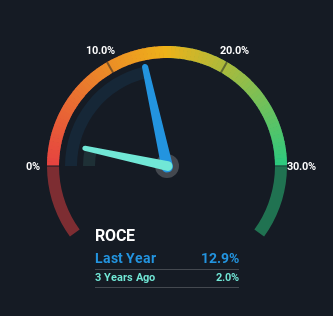When we're researching a company, it's sometimes hard to find the warning signs, but there are some financial metrics that can help spot trouble early. Businesses in decline often have two underlying trends, firstly, a declining return on capital employed (ROCE) and a declining base of capital employed. Ultimately this means that the company is earning less per dollar invested and on top of that, it's shrinking its base of capital employed. In light of that, from a first glance at MOIL (NSE:MOIL), we've spotted some signs that it could be struggling, so let's investigate.
Understanding Return On Capital Employed (ROCE)
For those that aren't sure what ROCE is, it measures the amount of pre-tax profits a company can generate from the capital employed in its business. To calculate this metric for MOIL, this is the formula:
Return on Capital Employed = Earnings Before Interest and Tax (EBIT) ÷ (Total Assets - Current Liabilities)
0.13 = ₹3.1b ÷ (₹28b - ₹3.4b) (Based on the trailing twelve months to December 2023).
Therefore, MOIL has an ROCE of 13%. In absolute terms, that's a pretty normal return, and it's somewhat close to the Metals and Mining industry average of 15%.
View our latest analysis for MOIL

In the above chart we have measured MOIL's prior ROCE against its prior performance, but the future is arguably more important. If you'd like, you can check out the forecasts from the analysts covering MOIL for free.
What Can We Tell From MOIL's ROCE Trend?
There is reason to be cautious about MOIL, given the returns are trending downwards. Unfortunately the returns on capital have diminished from the 18% that they were earning five years ago. And on the capital employed front, the business is utilizing roughly the same amount of capital as it was back then. Companies that exhibit these attributes tend to not be shrinking, but they can be mature and facing pressure on their margins from competition. If these trends continue, we wouldn't expect MOIL to turn into a multi-bagger.
The Key Takeaway
In summary, it's unfortunate that MOIL is generating lower returns from the same amount of capital. Since the stock has skyrocketed 111% over the last five years, it looks like investors have high expectations of the stock. In any case, the current underlying trends don't bode well for long term performance so unless they reverse, we'd start looking elsewhere.
One more thing to note, we've identified 1 warning sign with MOIL and understanding this should be part of your investment process.
While MOIL isn't earning the highest return, check out this free list of companies that are earning high returns on equity with solid balance sheets.
New: Manage All Your Stock Portfolios in One Place
We've created the ultimate portfolio companion for stock investors, and it's free.
• Connect an unlimited number of Portfolios and see your total in one currency
• Be alerted to new Warning Signs or Risks via email or mobile
• Track the Fair Value of your stocks
Have feedback on this article? Concerned about the content? Get in touch with us directly. Alternatively, email editorial-team (at) simplywallst.com.
This article by Simply Wall St is general in nature. We provide commentary based on historical data and analyst forecasts only using an unbiased methodology and our articles are not intended to be financial advice. It does not constitute a recommendation to buy or sell any stock, and does not take account of your objectives, or your financial situation. We aim to bring you long-term focused analysis driven by fundamental data. Note that our analysis may not factor in the latest price-sensitive company announcements or qualitative material. Simply Wall St has no position in any stocks mentioned.
About NSEI:MOIL
MOIL
Engages in the exploration, development, and marketing of various grades of manganese ores in India and Internationally.
Flawless balance sheet with high growth potential and pays a dividend.
Market Insights
Community Narratives



